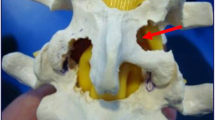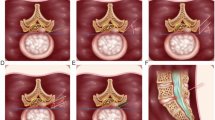Abstract
Purpose
This study aims to evaluate the efficacy and safety of the full-endoscopic lumbar discectomy (FELD) via lateral superior articular process (LSAP) approach and full-endoscopic transforaminal discectomy (FETD) for treating far lateral lumbar disk herniation (FFLDH).
Methods
From January 2020 to June 2022, patients who were diagnosed as FLLDH underwent the FELD via LSAP approach or FETD. The operation time, estimated blood loss, length of hospital stays, and complications were recorded. The visual analog scale (VAS) for back pain, VAS for leg pain, and the Oswestry Disability Index (ODI) scores was measured during preoperative and postoperative follow-up.
Results
Thirty-two patients were enrolled in this study, of which 12 patients were treated with the FELD via LSAP approach (LSAP-FELD group) and 20 patients underwent FETD (FETD group). The LSAP-FELD group exhibited significantly shorter operation times and hospital stays compared to the FETD group, while no statistically significant differences were observed in intraoperative blood loss and complication rates. There were no significant differences in the VAS for back pain, the VAS for leg pain, and the ODI score between the two groups preoperatively and three days, three months, and the last follow-up postoperatively.
Conclusions
Both the FELD via LSAP approach and FETD have demonstrated favourable clinical efficacy in the treatment of FLLDH. Notably, the FELD via LSAP approach shows the advantages of shorter operation time and hospital stays.





Similar content being viewed by others
Data availability
The raw data supporting the conclusions of this article will be made available by the authors.
References
Abdullah AF, Ditto ER, Byrd EB, Williams R (1974) Extreme-lateral lumbar disc herniations. Clinical syndrome and special problems of diagnosis. J Neurosurg 41(2):229–234. https://doi.org/10.3171/jns.1974.41.2.0229
Epstein NE (2002) Foraminal and far lateral lumbar disc herniations: surgical alternatives and outcome measures. Spinal Cord 40(10):491–500. https://doi.org/10.1038/sj.sc.3101319
Yeung AT, Tsou PM (2002) Posterolateral endoscopic excision for lumbar disc herniation: surgical technique, outcome, and complications in 307 consecutive cases. Spine (Phila Pa 1976) 27(7):722–731. https://doi.org/10.1097/00007632-200204010-00009
Hoogland T, Schubert M, Miklitz B, Ramirez A (2006) Transforaminal posterolateral endoscopic discectomy with or without the combination of a low-dose chymopapain: a prospective randomized study in 280 consecutive cases. Spine (Phila Pa 1976) 31(24):E890–E897. https://doi.org/10.1097/01.brs.0000245955.22358.3a
Zheng C, Wu F, Cai L (2016) Transforaminal percutaneous endoscopic discectomy in the treatment of far-lateral lumbar disc herniations in children. Int Orthop 40(6):1099–1102. https://doi.org/10.1007/s00264-016-3155-x
Uchikado H, Nishimura Y, Hattori G, Ohara Y (2020) Micro-anatomical structures of the lumbar intervertebral foramen for full-endoscopic spine surgery: review of the literatures. J Spine Surg 6(2):405–414. https://doi.org/10.21037/jss.2019.10.07
Montinaro A (2004) The microsurgical approach to extraforaminal lumbar disc herniations. An analysis of 15 cases. J Neurosurg Sci 48(1):23–28
Zhou Y, Zhang C, Wang J, Chu TW, Li CQ, Zhang ZF, Zheng WJ (2008) Minimally invasive strategies and options for far-lateral lumbar disc herniation. Chin J Traumatol 11(5):259–266. https://doi.org/10.1016/s1008-1275(08)60053-x
Zhang Y, Pan Z, Yu Y, Zhang D, Ha Y, Yi S, Shin DA, Sun J, Koga H, Phan K, Azimi P, Huang W, Cao K (2018) The modified transforaminal endoscopic technique in treating intracanalicular combining foraminal and/or extraforaminal lumbar disc herniations. Quant Imaging Med Surg 8(9):936–945. https://doi.org/10.21037/qims.2018.10.02
Zhu Y, Huang R, Tao X, Xu X (2021) Short-term efficacy of percutaneous transforaminal endoscopic BEIS technique for L4 /5 far lateral lumbar disc herniation. J Minim Invasive Med 16(05):630–633. https://doi.org/10.11864/j.issn.1673.2021.05.08
Chang H, Xu J, Yang D, Sun J, Gao X, Ding W (2023) Comparison of full-endoscopic foraminoplasty and lumbar discectomy (FEFLD), unilateral biportal endoscopic (UBE) discectomy, and microdiscectomy (MD) for symptomatic lumbar disc herniation. Eur Spine J 32(2):542–554. https://doi.org/10.1007/s00586-022-07510-6
Park JH, Jung JT, Lee SJ (2018) How I do It: L5/S1 foraminal stenosis and far-lateral lumbar disc herniation with unilateral bi-portal endoscopy. Acta Neurochir (Wien) 160(10):1899–1903. https://doi.org/10.1007/s00701-018-3630-9
Aydın AL, Sasani M, Sasani H, Üçer M, Hekimoğlu M, Öktenoğlu T, Özer AF (2020) Comparison of two minimally invasive techniques with endoscopy and microscopy for extraforaminal disc herniations. World Neurosurg 144:e612–e621. https://doi.org/10.1016/j.wneu.2020.09.022
Funding
Project Supported by Scientific and Technological Research Program of Chongqing Municipal Education Commission (Grant No. KJQN202200425).
Author information
Authors and Affiliations
Contributions
Conception and design: Xiao-Lin Chen, Zhen-Yong Ke, and Lu Lin; collection of the clinical data: Lu Lin and Lei Chu; statistical analysis: Yun Cheng and Guo-Sheng Zhao; investigation and the relevant literature review: Dian Zhong and Xin Cai; manuscript writing: Lu Lin and Xiao-Lin Chen; revision of the paper: Xiao-Lin Chen. All authors read and approved the final manuscript.
Corresponding author
Ethics declarations
Ethical approval
This study involving human participants was reviewed and approved by the Ethics Committee of the Second Affiliated Hospital of Chongqing Medical University.
Consent for publication
All authors agreed to publish the paper.
Informed consent
All patients signed the informed consent form before study inclusion.
Conflict of interest
The authors declare no competing interests.
Additional information
Publisher’s note
Springer Nature remains neutral with regard to jurisdictional claims in published maps and institutional affiliations.
Rights and permissions
Springer Nature or its licensor (e.g. a society or other partner) holds exclusive rights to this article under a publishing agreement with the author(s) or other rightsholder(s); author self-archiving of the accepted manuscript version of this article is solely governed by the terms of such publishing agreement and applicable law.
About this article
Cite this article
Lin, L., Ke, ZY., Chu, L. et al. Full-endoscopic lumbar discectomy via lateral superior articular process approach for treating far lateral lumbar disc herniation: a retrospective study and technical note. International Orthopaedics (SICOT) 47, 2843–2850 (2023). https://doi.org/10.1007/s00264-023-05937-0
Received:
Accepted:
Published:
Issue Date:
DOI: https://doi.org/10.1007/s00264-023-05937-0




